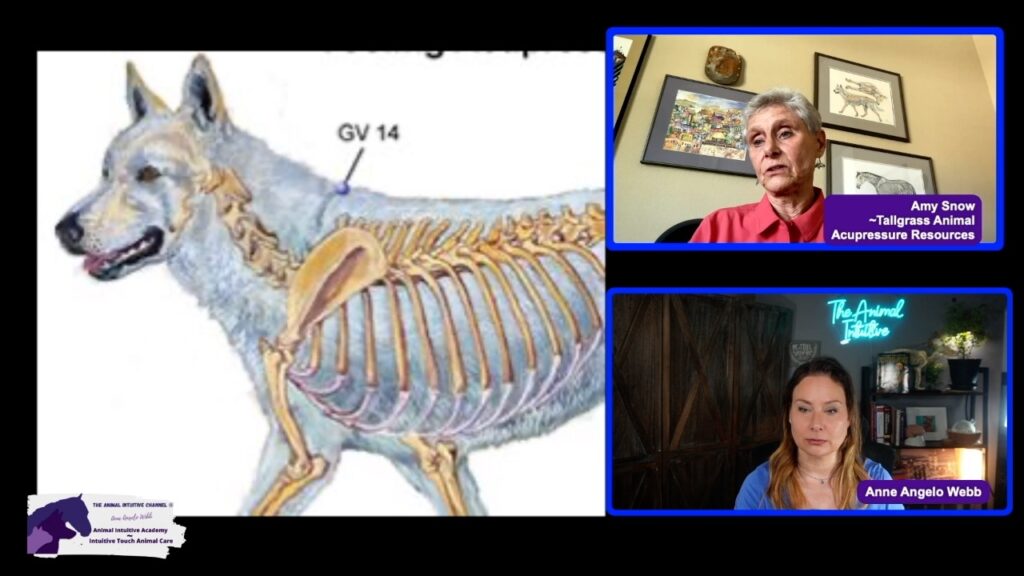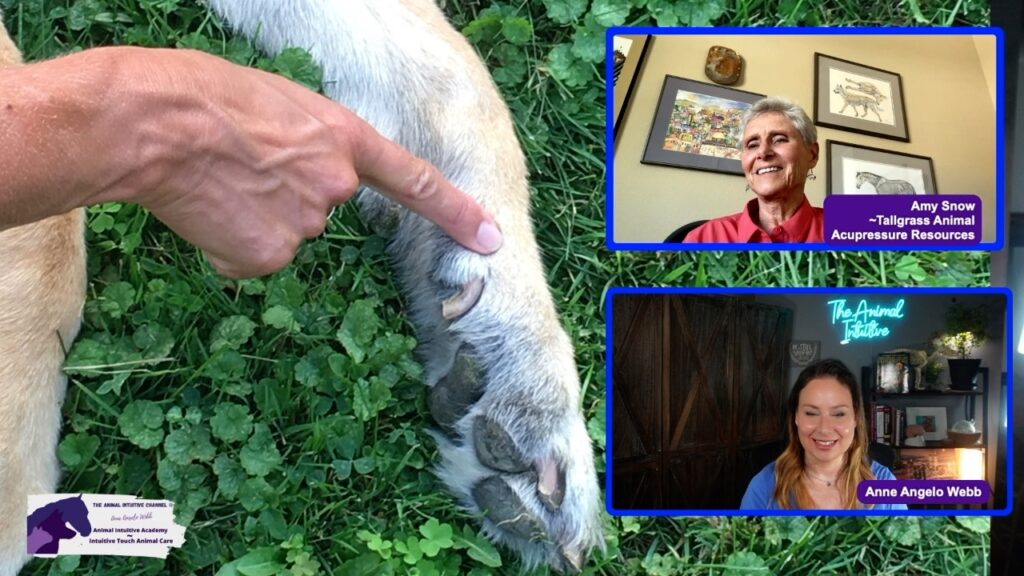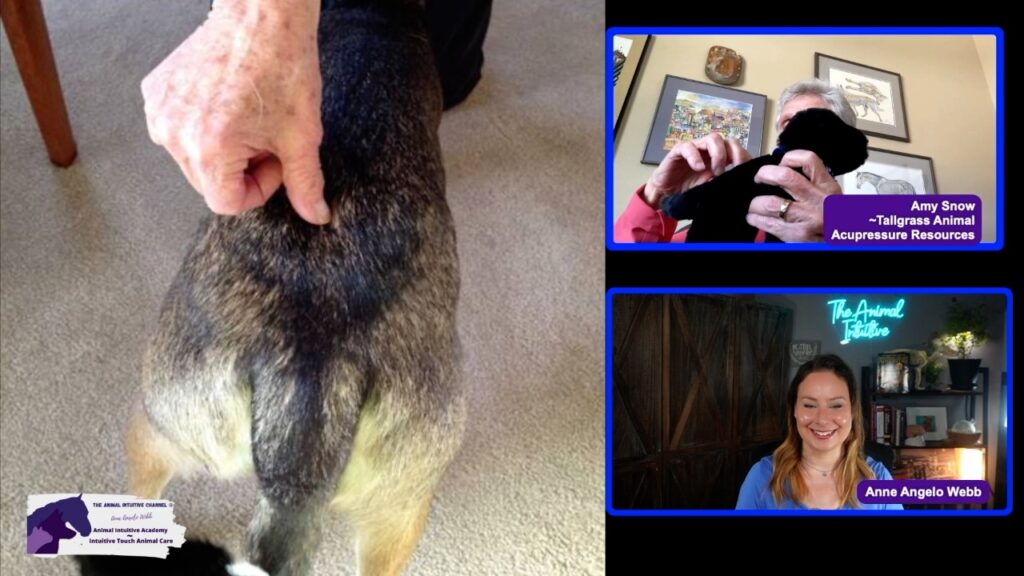Watch the timestamped video – CLICK ABOVE or HERE
Please subscribe to the channel so you don’t miss an episode to benefit you and your pets! You’re helping to grow the community and channel (your likes, shares, and subscribes help to tell the YT algorithm to show the channel to more people), which I sincerely appreciate!
🐾 Note: Acupressure is not a substitute for veterinary care. If your pet has behavioral or health issues, consult your veterinarian. While generally safe, always check with your vet if you’re unsure.
How to Prevent Heatstroke in Dogs: Early Signs, Acupressure Techniques, and Natural Cooling Tips
Go straight to animal acupressure points: CLICK HERE
If you would like to skip down to the Tallgrass Animal Acupressure Resources – Summer Danger Zone HEAT free pdf – CLICK HERE
As temperatures rise, many pet parents assume heatstroke is only a risk on triple-digit days. But the truth is: your dog can overheat at just 80°F (27°C)—especially certain breeds and puppies. Heat exhaustion can escalate into a life-threatening emergency in minutes, which is why it’s vital to learn the early signs and know what to do.
In this post, we’ll explore how to prevent dog heatstroke using natural methods, hydration tips, and Traditional Chinese Medicine-based acupressure techniques from Amy Snow of Tallgrass Animal Acupressure Resources guest appearence on The Animal Intuitive® Channel.
Founded by Amy Snow and Nancy Zidonis, Tallgrass has been the gold-standard for animal acupressure training globally for over 25 years. Their programs combine Traditional Chinese Medicine theory with safe, hands-on acupressure techniques.
They’ve trained:
- Veterinarians
- Animal chiropractors
- Bodyworkers
- Pet parents
- … in over 20 countries, including the U.S., U.K., Australia, and Canada.
Their well-known books and charts like Acu-Dog are considered gold standards in the field.
Why Dogs Overheat Easily
Amy explains that dogs regulate their body temperature very differently than humans. Instead of sweating, they rely primarily on panting and minimal sweat glands in their paws. When it’s hot and humid, these cooling systems can quickly become overwhelmed.
Even a pleasant sunny day can be dangerous—many dogs suffer heatstroke at temperatures as low as 80°F (27°C). Pavement, direct sun, and lack of ventilation increase the risk exponentially.
Amy Highlights Which Dogs Are Most At Risk?
Not all dogs handle heat the same way. Some are particularly vulnerable to overheating and heatstroke:
- Brachycephalic breeds (Pugs, Bulldogs, Shih Tzus)
- Dogs with heavy coats (Huskies, Newfoundlands, Collies)
- Puppies and senior dogs
- Overweight or obese dogs
- Dogs with respiratory or heart conditions
💡 Tip: If your dog falls into one of these categories, avoid midday walks, keep them hydrated, and know the signs of heatstroke (next section).
Early Warning Signs of Heatstroke in Dogs
Knowing what to look for could save your dog’s life. Even mild signs can quickly escalate. Here are the most common symptoms of heatstroke in dogs as summarized by Amy:
- Loud, frantic panting
- Bright red or dark-purple gums and tongue
- Drooling or foaming at the mouth
- Weakness or disorientation
- Vomiting or diarrhea
- Tremors or seizure-like activity
- Collapse or loss of consciousness
⚠️ If you notice any combination of these signs, start cooling your dog immediately and call your vet.
Immediate Steps to Cool an Overheated Dog
If your dog is showing signs of heatstroke, here’s what to do right away:
- Move to a shaded or air-conditioned area
- Spray or sponge with cool (not ice-cold) water
- Use a fan to improve ventilation
- Offer cool water in small amounts
- Avoid ice packs directly on the body
- Call your vet, even if symptoms improve
Amy emphasizes: “You don’t want to cool your dog too quickly or with ice. That can actually restrict blood flow and trap heat inside.”
Acupressure Points to Cool Dogs Naturally
Amy Snow, Tallgrass Acupressure Resources Co-Founder Explains How To Do Acupressure On Your Pet
🐾 Important: Always be gentle. Acupressure is not massage. You’re encouraging energy flow, not forcing it.
These techniques can be especially helpful on the way to the vet or when your dog is recovering from heat stress.
🐾 How to Press the Points Correctly:
-
Apply gentle pressure—never deep or forceful.
-
Start with a slow, steady contact, hold for at least a slow count of 20, then gradually release.
-
Use a rhythmic in-and-out motion:
-
Lightly press in
-
Hold briefly
-
Release gently
-
Repeat
-
Why Gentle Touch Matters:
-
The meridians lie just beneath the skin, especially in dogs with relatively thin skin.
-
Applying too much pressure actually stagnates the flow of energy (chi) and may block or disrupt the healing process.
-
Think of your goal as guiding energy, not forcing it.
⚠️ What Not to Do:
-
Avoid digging, kneading, or applying intense pressure (“this is not Rolfing or deep tissue massage”).
-
Don’t try to “fix” the body—acupressure helps encourage the body’s own healing systems.
🌿 Summary of Core Teaching:
Amy emphasizes that acupressure is about creating a harmonious flow of chi (energy) throughout the animal’s body—not about imposing control. When you stimulate points gently and intentionally:
-
You help the body release excess heat, especially in emergency cases like heatstroke.
-
You begin the process of rebalancing energy (yin and yang) so the body can heal itself.
-
Only the body can restore its balance—you’re simply facilitating that natural process.
-
In cases like heatstroke, where the body is shutting down and organs are distressed, your calm, skilled intervention can help stabilize the system until professional care is reached.
1. Governing Vessel 14 - GV 14
Location:
Find the nape of the neck—right where the neck meets the shoulders.
Use light, rhythmic scratching (not pressure) across this area.
Continue until you or your dog have had enough—there’s no strict time limit.
This is the #1 cooling point on the dog’s body in Traditional Chinese Medicine.
It helps release heat through the governing vessel meridian, which runs along the spine and top line of the body.
It’s also helpful for dogs experiencing seizures, which are often caused by internal heat rising.
Panting may increase during stimulation—this is a normal and healthy response.
This point is safe to use during active seizures, and can help calm the body quickly.
Works well when combined with other cooling measures like ventilation and spraying water.
🔺 What You’re Doing:
Activating the body’s natural heat-release mechanism.
Encouraging energy flow without force or pressure.
Starting the cooling and balancing process from the nervous system outward.
⚠️ Emergency Tip:
If your dog is collapsed or showing extreme signs of overheating, this point can be used alongside other first-aid steps (moving to a cool space, spraying with water, fan, and veterinary help).

2. Governing Vessel 26 - GV26 (Emergency Shock Point)
Just beneath the nose, in the center of the groove between the nose and upper lip
How to Apply Acupressure to GV26:
Place your hand gently on your dog’s muzzle.
Use light pressure at first, then gradually press more firmly for a moment.
Release and repeat: firm pressure in, then release out.
You may also use a quick “flicking” motion with your finger to stimulate the point in more severe cases.
❗ Important Safety Note:
Do NOT use this point if there’s any chance of your dog biting due to distress or confusion.
If your dog is out of control, aggressive, or highly reactive, skip this point to avoid injury.
Always prioritize your safety first during emergency situations.
When to Use GV26:
Dog is collapsed or showing signs of loss of consciousness
Dog is in shock
Experiencing severe respiratory distress
As a revival point for near-drowning, heatstroke, or other emergencies
Sometimes used to stimulate a newborn puppy’s first breath (this is also done by veterinarians)
Why It Works:
GV26 stimulates the entire central nervous system
It’s often referred to as the “super emergency point” in Traditional Chinese Medicine
Can revive consciousness, stimulate breathing, and reboot systemic function

3. Large Intestine 4 - LI4
🐾 Location:
Found in the webbing between the dog’s thumb (dewclaw) and first toe on the top side of the paw.
It’s similar to the fleshy area between your thumb and index finger in humans.
How to Apply Acupressure to LI4:
Gently pinch the webbing between your dog’s dewclaw and first toe.
Press back toward the paw bone with light, consistent pressure.
Hold the point for a few seconds, then release. Repeat with a gentle rhythm.
❗ Safety & Notes:
This point is easy to reach and well-tolerated by most dogs.
It’s a great option if your dog won’t tolerate work on the head or face (such as GV26).
It may not be as strong as GV26 or GV14 in an emergency, but it’s still highly effective for cooling and general support.
When to Use LI4:
For cooling during overheating or mild heat stress
On the way to the vet during more serious overheating episodes
As part of a daily wellness routine
Whenever you feel unsure which point to use (“When in doubt, use LI4” is a common saying in TCM circles)
Why LI4 is Powerful:
LI4 is considered a universal balancing point in Traditional Chinese Medicine.
It’s known for its ability to release heat, stimulate circulation, and restore balance.

4. Bai Hui - "Feel-Good" Point
🐾 Location on Animals (Bai Hui):
Found on the top of the sacrum—the flat, soft area between the hips at the base of the spine.
To locate it: Feel for the soft “baby trampoline” spot midway between the tops of the hip bones.
There are no spinous processes (bony ridges) there, which makes it safe and gentle to work with.
🐶 How to Apply Acupressure to Bai Hui (Animal Version):
Use light, rhythmic scratching over the Bai Hui point.
Let your fingers move naturally—like giving a comforting scratch.
This stimulates energy and encourages cooling and calm.
Most dogs absolutely love this point—it’s often called the “feel-good point.”
🧘 Location on Humans (GV20):
GV20 is found on the very top center of the head, in line with the tips of the ears.
After working with Bai Hui on your dog, you can gently scratch or massage this area on yourself to bring mutual calming energy and connection.
Why Bai Hui Is Powerful:
It’s considered the closest point to Heaven in Chinese Medicine—representing deep energetic connection.
In animals, it’s where energy converges and can be used to release excess heat, especially when paired with points like GV14 and LI4.
It is deeply balancing, especially in heat-related or stress situations.
When to Use Bai Hui:
To reduce heat from the body
To promote a calming, feel-good effect during acupressure or stressful events
As a daily wellness or bonding routine
As part of your cool-down acupressure sequence following heat stress, high activity, or emotional upset
🧠 Bonus Insight (from Amy’s experience):
Bai Hui’s location in animals reflects their posture—when eating happily with their heads down and tails up, this point becomes the energetic high point, hence its deep significance.
Though acupressure began as folk medicine, modern studies support how stimulation of meridians affects internal organs and the body’s ability to self-regulate and cool.

5. Liver 2 - LV 2
🐾 Location:
On the inner side of the front paw, at the base of the inner nail (most medial nail).
From the tip of the inner toe, go back one joint—just behind the nail bed.
This is a small, specific spot but highly effective once located.
How to Apply Acupressure to Liver 2:
Gently hold the point between your fingers.
There’s no need to rub, dig, or press hard—just holding it allows the energy to shift.
Apply light pressure for a few seconds to a minute, depending on your dog’s comfort and your intuition.
⚠️ Handling Tips:
Because this point is near the end of the paw, it may be more sensitive—approach slowly and with calm energy.
If your dog pulls away, try again when they’re relaxed or after working other points.
Why Liver 2 Is Powerful:
In Traditional Chinese Medicine, points near the tips of limbs are the most energetically influential.
Liver 2 is especially effective for moving stagnant energy, cooling heat, and calming excess emotional energy.
It’s known as a “fire point”, which helps clear heat from the liver system—important in stress, overheating, or frustration.
When to Use Liver 2:
As part of your cooling protocol during heat stress
If your dog is agitated or irritable (common liver imbalance signs)
To calm energy or cool the system in times of high heat or emotional imbalance
Can be used on the way to the vet if your dog is overheating or disoriented

Conclusion: Empowering Pet Parents Naturally
By knowing how to prevent and how to identify early signs of overheating and applying gentle acupressure techniques, you don’t have to feel helpless. You can buy critical time and help your dog recover faster by knowing these tips and utilizing acupressure.
Through the teachings of experts like Amy Snow and the Tallgrass team, natural wellness becomes accessible, safe, and incredibly effective.
Learn To Communicate With Animals
Hi, I’m Anne Angelo Webb, The Animal Intuitive—owner of Intuitive Touch Animal Care and the Animal Intuitive Academy.
I’m nationally board certified in animal acupressure and massage, a professional animal communicator and instructor, and a Licensed Clinical Social Worker who now specializes in hypnosis and brainspotting.
For over 20 years, I’ve been helping animals and the people who love them feel more connected—whether through consultations, education, or creative projects like my children’s book and companion album.
I love empowering pet parents like you to support your animals’ emotional and physical well-being from home.
Keep reading for this week’s calming acupressure techniques, a special grounding practice just for you—and a limited-time offer to help deepen your intuitive connection with your animal.
Special Offer: 10% Off All Digital Products Including Animal Communication & Acupressure Courses and Hypnosis for Animal Communicators
To help deepen your intuitive bond with your animal, I’ve created a brand-new hypnosis audio:
Hypnosis for Confidence and Releasing Doubt in Telepathic Animal Communication—enhanced with binaural beats.
👉Get your 10% off all digital products offer HERE
Meesha’s Heart Adventure is a beautifully crafted story that entertains and educates children about resilience, courage, and the deep connections we share with animals. The author’s expertise as a Licensed Clinical Social Worker and animal communicator shines through, offering gentle guidance on managing fears, building confidence, and understanding the unspoken bond between humans and animals.
Kristen T.
Animal Intuitive Academy offers courses to deepen your skills, and you can start today with my digital course, Animal Communication, Acupressure, and Mindfulness!




